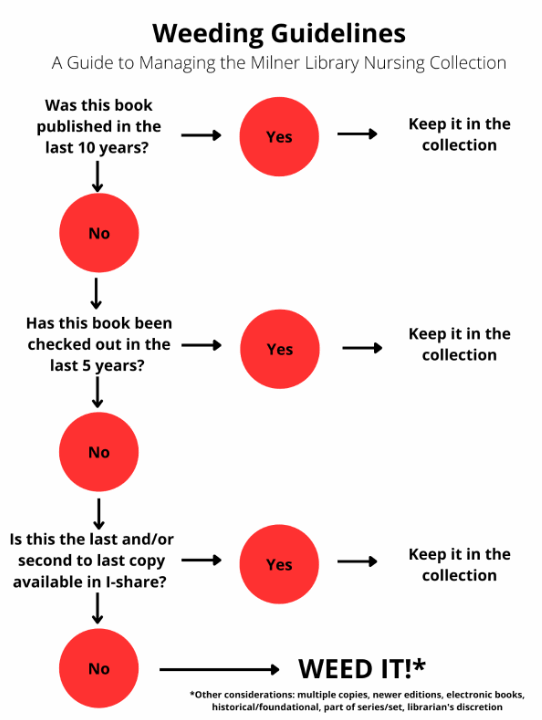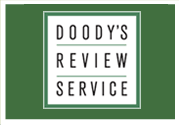|
Laura Killingsworth, MLIS
Nursing Librarian
Mennonite College of Nursing
Illinois State University Editor’s note: This article is based on a presentation given at the Midwest Chapter/MLA annual meeting in 2023, a recording for which can be found here. Introduction In the summer of 2022, the nursing collection at Illinois State University’s Milner Library contained approximately 17,000 items. Concerns about the state of the collection had been raised by both the dean of the college of nursing and the dean of Milner Library. In nursing, having current materials is extremely important, as anything out-of-date is at best unhelpful and, at worst, has the potential to be hazardous or life-threatening. From a librarianship perspective, it is important to critically evaluate the state of collections to ensure they meet the research and curricular needs of their community. As a practical matter, materials need to be regularly reviewed to account for shelf space as well as lower circulation statistics. For this collection, it was time for a serious evaluation. A large-scale weeding project had not taken place since 2015, and it is possible that a project of this scale had not been completed since the standalone Mennonite College of Nursing (MCN) and affiliated collection was absorbed by Illinois State University in 1999. Milner Library did have a loose collection development policy that covered the scope of the collection, though it did not touch on the topic deaccessioning. I set out to create a set of weeding guidelines appropriate to this collection and undergo an initial deaccessioning project affectionately referred to as “The Big Weed.” Development of weeding guidelines The first thing that needed to be done was to create a set of weeding guidelines. At the time, there were no set guidelines for weeding the nursing collection, nor was it clear whether a large-scale, systematic weeding project had taken place. After a review of the literature (e.g., Robinson, 2013) and discussions with other professionals in the field, the following criteria were deemed most important for consideration: age and/or publication date, last circulation date, and the number of copies in I-Share (state of Illinois consortium.) Ultimately, this led to the development of a set of questions and corresponding flowchart: 
Image 1: Flowchart of weeding guidelines for the Milner Library nursing collection - Was this book published in the last ten years?
- If yes, keep it in the collection.
- If no, move on to next question.
- Has this book been checked out in the last five years?
- If yes, keep it in the collection.
- If no, move on to next question.
- Is this the last and/or second to last copy available in I-Share?
- If yes, keep it in the collection.
- If no, consider weeding this item!
Of note, there were other factors considered such as number of copies, editions, availability of titles in electronic book format, historical and/or foundational significance, and part of a series, which is why these were merely set out as guidelines and final decisions were ultimately made at the discretion of the subject librarian. Armed with these newly fleshed out guidelines, it was time to begin the actual process of pulling titles. Completion of initial weed The first step was to acquire the ALMA statistics spreadsheet for the corresponding sections of the collection from the Alma Specialist in Technical Services. These spreadsheets contained valuable bibliographic information, noted in the newly created guidelines, to make deaccessioning determinations. Next, items that were over 10 years old and had not been checked out in the last five years were highlighted. Then, the highlighted titles were searched in the catalog to ensure titles were not the last or second-to-last copy in I-Share. If they were, the highlight was removed, and a note was made in the far-right column of the spreadsheet to leave in the collection. An Excel spreadsheet with bibliographic data from approximately 20 different titles. Some have been highlighted, which indicates it is a title that has been identified for weeding. 
Image 2: Screenshot of spreadsheet with bibliographic information, ALMA statistics, and highlights As suggested in the guidelines, other titles were removed from consideration based on other factors. For example, one title, Callista Roy: An adaptation model, met the preliminary criteria for weeding: it had not been checked out in over five years, it was published over 10 years ago, and there were multiple copies available in I-Share. However, Roy’s nursing theory is of historical significance to the field of nursing and Roy is one of several theorists that PhD students at the Mennonite College of Nursing may choose for a concept analysis paper in their first semester of graduate studies. Since this title is historically significant to nursing and also has a direct curricular impact, it remained in the collection. Shisler (2007) provides additional questions to ask when it comes to evaluating a nursing collection with historical considerations in mind. After determining which titles were candidates for removal from the collection, the librarian pulled items from the shelves and sent them to technical services for withdrawal. Of 16,947 records in the original spreadsheet data, 4,601 titles were identified as candidates for removal (~27% of the physical collection.) This varied wildly from one call number range to another. Of the first 2,700 titles of RA section (classified as Public Aspects of Medicine by the Library of Congress Classification system), 38% of the titles were removed from the collection. In one snapshot of the RT section focused on nursing theories and nursing history, less than 20% of identified titles were removed from the collection, and most of them were books of which the library owned multiple copies. For these examples, the librarian elected to keep just one copy. Moving forward, it is expected that future deaccessioning endeavors will result in these proportions being much lower. Conclusions and thoughts for the future Moving forward, a plan for future, less daunting collection management endeavors has been devised in the hopes of limiting the need for thousands of titles to be removed at one time. A three-year collection management cycle was created, inspired by Price, M. (2013) and adapted for these specific collection assignments within the Library of Congress Classification system: - Year 1: QP, R, RD, RT
- Year 2: RB, RC, RE, RG, RJ, RK, RL, RM, RS, RV, RX, RZ
- Year 3: RA
This provides an opportunity to narrow the focus to targeted areas for both acquisitions and weeding in a given year. Weeding is an essential part of the collection management process. It can also be extremely anxiety-inducing and easy to put off. This can be especially true for librarians who are new to an institution, less knowledgeable about best practices related to their collection areas, or even to the profession of librarianship itself. Knowing where to begin or what criteria to even consider is a challenging but crucial step to taking on a deaccessioning project of any scale. With some starting guidelines, advice from trusted colleagues, and some confidence and trust in one's own unique knowledge and skillset, the process can hopefully become a little less daunting on the way to curating a beneficial and well-utilized nursing collection. References Price, M. (2013). Collection development in nursing: Weeding for collection strength. In S. Holder (Ed.), Library collection development for professional programs: Trends and best practices (pp. 375-389). IGI Global. http://www.doi.org./10.4018/978-1-4666-1897-8.ch022 Robinson, J. (2013). Issues in collection development planning: Supporting the College of Health Sciences and Human Services and the School of Nursing at Murray State University. In S. Holder (Ed.), Library collection development for professional programs: Trends and best practices (pp. 306-326). IGI Global. http://www.doi.org./10.4018/978-1-4666-1897-8.ch018 Shisler, Carol M. (2007). Evaluating your nursing collection: A quick way to preserve nursing history in a working collection. Journal of the Medical Library Association, 95(3), 278-283. http://www.doi.org/10.3163/1536-5050.95.3.278 DCT Featured Article – February 11, 2025
|
